The couple purchased and renovated a building dating back to 1884 in the Mansfield borough because Dr. Strohecker needed more space to house one of his practices and because the couple shares a passion for real estatein particular, restoration of the old.
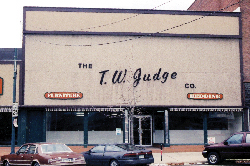 |
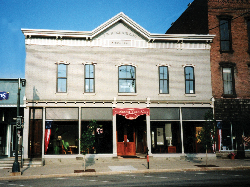 |
| Although renovating the historic T.W. Judge Building (left) cost almost $1 million, Dr. Strohecker says he is definitely seeing the fruits of his labor with his brand new practice (right). Courtesy: Jeannine Reese |
Since his first purchase, he and Sondi have bought 12 properties together. She has this amazing eye for design, so shes always coming up with these great ideas on how to match furniture and bric-a-brac with the interior style of a building, he says. Shes the form, and Im the function.
This article, the first in a three-part series discussing what your colleagues have done to better their practices, demonstrates how Dr. Strohecker created a practice that not only meets his professional needs, but his personal and financial needs as well.
A Case of Space
Dr. Strohecker had practiced optometry in a 1,500 square-foot building for 14 years when, in 2001, he decided it was time to find a larger building to house his practice.
When you practice optometry in rural Pennsylvania, you do a lot of disease-based eye care, which requires medical equipment that takes up a lot of space, Dr. Strohecker says. In addition, myself and another optometrist are doing 6,000 exams a year, so my staff and our patients were practically falling all over one another.
In November of 2001, the couple heard about the sale of a building that was located just yards from his Mansfield practice.
Historic Building For Sale
The property, known as the T.W. Judge Building, was well known to Mansfield residents, as it had been passed down within one family since 1884 and was originally a mercantile. The two-story building was 11,000 square feet and includ-ed a storefront. Also included: a separate 3,000-square-foot back-lot warehouse. At the time, the building housed an appliance/furniture store that was going out of
business.
The building looked as if it probably hadnt undergone any type of renovation since the 1970s. It was pretty awful, Dr. Strohecker says. It had this really tacky pebble-board faade. Underneath that was this stucco product that was made to look like yellow brick. The stucco product had been fixed to the original 1884 brick structure in the 1950s, so the original brick was ruined.
The inside was no better. The original maple floors were layered with commercial carpeting, linoleum and underlayment, Dr. Strohecker says. In addition to that, the walls contained displays covered over with masonite boards held together by vinyl strips.
What attracted me to this building was the size, Dr. Strohecker says. All my practice needed was 4,000 square feet, so I figured I could support some of the debt involved in buying and renovating the building by renting the remaining 7,000 square feet, and eventually, the 3,000 square feet in the warehouse.
After a few visits to the not-so-pretty property, the couple became inspired. As we walked around, we both began to see what this building could be, and we became very excited at the prospect of revamping it, Dr. Strohecker says.
The couple became the owners of the former furniture/appliance store in February 2002 after obtaining a loan from the local bank, agreeing on a monthly-payment plan with the prior owners, who held a large note on the property, and securing a low-interest loan from a state redevelopment program.
Cleaning House and Making Plans
The Stroheckers began the renovation project in May 2002 by hiring a contractor to gut the interior. During this time, the couple began working on the floor plan of the practice with a company known for optometric and ophthalmic office design.
The companys preliminary design ideas focused on the importance of staff and patient flow, which Dr. Strohecker liked. But, the couple wasnt thrilled with the companys frame boards. We decided to just purchase the companys maple boards with the frame hangers and have them incorporated into a custom design, Mrs. Strohecker says.
The couple also hired an architect who had some design capabilities. My wife and I both find asymmetry visually appealing, so thats what we wanted for this building, and we conveyed that to the architect, Dr. Strohecker says. From there, the architects plans for both the interior and the exterior were sent to the local and state building code authorities.
The Stroheckers first order of business on the interior was the flooring. When the contractors gutted the building, we discovered that the original wood flooring under one area was so rotted, that there was actually an opening in the floor, Dr. Strohecker says. Also, the sections of the flooring that were intact were really dirty, dimpled, gouged and chipped.
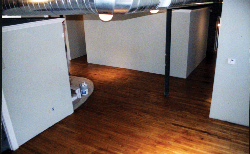 |
| The sections of the maple floor that were rotted or missing were filled with mahogany planks. Then, the floors were sanded and polished. I knew that wed have to do some patchwork where the flooring had rotted away, but I felt that if we sanded down the rest, it could look really great, Mrs. Strohecker says. I felt that imperfections gave the flooring and the interior character. Courtesy: Jeannine Reese |
When the flooring was sanded and finished, however, Dr. Strohecker says he was shocked. I admitted that Sondi was right, he says. The floors really did end up looking beautiful.
At this point, the skeletal-looking interior began taking on flesh in the form of walls, doors and more. In keeping with our idea for asymmetry, we had the exam rooms built to only reach eight of the 12 feet of the actual ceiling, Dr. Strohecker says. The couple also wanted the interior to have a warehouse feel, so they suspended steel ductwork and rod lighting from the ceiling.
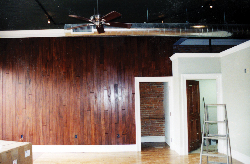 |
| One of the walls in the reception area was an unattractive fire-wall. To make it match the dcor of the rest of the interior, Dr. Strohecker and the floor contractor put the mahogany planks that were left over from the flooring on the wall. Courtesy: Jeannine Reese |
In addition to the frame boards, the cabinet-maker also built the practices 30-foot-long reception desk, which was the brain-child of Mrs. Strohecker. I saw this countertop that came out of a turn-of-the-century bank, and I immediately thought that look would go perfect with the look of the office, she says. So, I worked with the cabinet-maker on the design of that.
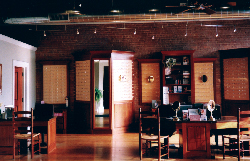 |
| At first, the cabinet-maker created a design in which all of the frame boards were straight across against the walla look that would clash with the Stroheckers desire for asymmetry. So, the couple tweaked the cabinet-makers ideas, and the three of them created a design in which the frame boards not only have vertical dimension but dimension of depth as well. Courtesy: Jeannine Reese |
The finishing touches on the interior came in the form of soft, cushioned leather chofas (couch/chair hybrids), leather couches, old-fashioned kitchen chairs, a black checker/chess board table and chair set, antique-looking lamp stands and dark-colored area rugs. Then came the faade redesign.
 |
| The countertop of the 30-foot long reception desk is made of composite granite and polymer. It is supported by a mahogany bottom that has four-inch-wide pillars at every corner of the countertop. Courtesy: Jeannine Reese |
The first thing removed from the faade of the building was the
pebble-board. This revealed three windows that the couple knew were there from working on the interior. We removed those windows and began the process of replacing them with five, 19th century-looking windows, Dr. Strohecker says.
From there, a peak, which would later read T.W. Judge Building Circa 1884, was placed at the top of the faade. White molding was placed along the entire perimeter of the top. The small awnings that hung over the two first floor windows were removed. Then, the entire exterior was painted a light green. The final touch: a red sign in the shape of a banner with Strohecker Vision Carewritten in beige and a pair of over-sized spectacles below it.
Time Was Not on Their Side
During this entire process, the couple simultaneously renovated the storefront to the left. They also attended to their individual duties. I am a stay-at-home mom of three boys (9-month-old Landis and 11-year-old twins Alexander and Anthony), Mrs. Strohecker says. In addition to that, I handle the landlord duties of our other buildings during the day.
Dr. Strohecker is a self-proclaimed work-a-holic. An average work week for me is 60 hours. During this project, I worked about 100 hours-a-week, he says. I probably worked 35 to 40 hours-a-week with patients and about 60 hours-a-week on both overlooking the project and physically digging in and helping out with the hammering, the roofing and more.
In November 2004, the new practice project was completed. The second floor of the building currently houses a photography studio, a yoga studio and a psychologists office. The new storefront to the left houses an insurance business.
 |
| Dr. Strohecker says that the checkerboard table and chair set is especially popular with his young patients. Courtesy: Chris McGann |
 |
| Initially, the Stroheckers were going to install pre-made maho-gany doors. But, the pre-made doors, unfinished, cost $400 each. So, we talked to the cabinet-maker, and he built, finished and hung the doors for $600 a piece, Dr. Strohecker says. Courtesy: Chris McGann |
Next month in Practice Profiles Part 2, we talk to an optometrist who joined forces with a non-eyecare entity to offset the cost of his new practice and generate new patients.

